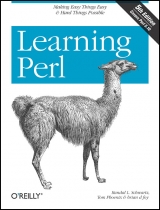
Learning Perl
O'Reilly Media, Inc, USA (Verlag)
978-0-596-10105-3 (ISBN)
- Titel ist leider vergriffen;
keine Neuauflage - Artikel merken
"Learning Perl", better known as "the Llama book", starts the programmer on the way to mastery. Written by three prominent members of the Perl community who each have several years of experience teaching Perl around the world, this latest edition has been updated to account for all the recent changes to the language up to Perl 5.8. Perl is the language for people who want to get work done. It started as a tool for UNIX system administrators who needed something powerful for small tasks. Since then, Perl has blossomed into a full-featured programming language used for web programming, database manipulation, XML processing, and system administration - on practically all platforms - while remaining the favorite tool for the small daily tasks it was designed for. You might start using Perl because you need it, but you'll continue to use it because you love it. Informed by their years of success at teaching Perl as consultants, the authors have re-engineered the Llama to better match the pace and scope appropriate for readers getting started with Perl, while retaining the detailed discussion, thorough examples, and eclectic wit for which the Llama is famous.
The book includes new exercises and solutions so you can practice what you've learned while it's still fresh in your mind. Here are just some of the topics covered: data structures, minimal matching, threading, data parsing, references, objects, modules, and package implementation. If you ask Perl programmers today what book they relied on most when they were learning Perl, you'll find that an overwhelming majority will point to the Llama. With good reason. Other books may teach you to program in Perl, but this book will turn you into a Perl programmer.
Randal L. Schwartz is a two-decade veteran of the software industry. He is skilled in software design, system administration, security, technical writing, and training. Randal has coauthored the "must-have" standards: Programming Perl, Learning Perl, Learning Perl for Win32 Systems, and Effective Perl Learning, and is a regular columnist for WebTechniques, PerformanceComputing, SysAdmin, and Linux magazines. He is also a frequent contributor to the Perl newsgroups, and has moderated comp.lang.perl.announce since its inception. His offbeat humor and technical mastery have reached legendary proportions worldwide (but he probably started some of those legends himself). Randal's desire to give back to the Perl community inspired him to help create and provide initial funding for The Perl Institute. He is also a founding board member of the Perl Mongers (perl.org), the worldwide Perl grassroots advocacy organization. Since 1985, Randal has owned and operated Stonehenge Consulting Services, Inc. Randal can be reached for comment at merlyn@stonehenge.com or (503) 777-0095, and welcomes questions on Perl and other related topics. Tom Phoenix has been working in the field of education since 1982. After more than thirteen years of dissections, explosions, work with interesting animals, and high-voltage sparks during his work at a science museum, he started teaching Perl classes for Stonehenge Consulting Services, where he's worked since 1996. Since then, he has traveled to many interesting locations, so you might see him soon at a Perl Mongers' meeting. When he has time, he answers questions on Usenet's comp.lang.perl.misc and comp.lang.perl.moderated newsgroups, and contributes to the development and usefulness of Perl. Besides his work with Perl, Perl hackers, and related topics, Tom spends his time on amateur cryptography and speaking Esperanto. His home is in Portland, Oregon. brian d foy has been an instructor for Stonehenge Consulting Services since 1998, a Perl user since he was a physics graduate student, and a die-hard Mac user since he first owned a computer. He founded the first Perl user group, the New York Perl Mongers, as well as the Perl advocacy nonprofit Perl Mongers, Inc., which helped form more than 200 Perl user groups across the globe. He maintains the perlfaq portions of the core Perl documentation, several modules on CPAN, and some stand-alone scripts. He's the publisher of The Perl Review, a magazine devoted to Perl, and is a frequent speaker at conferences including the Perl Conference, Perl University, MarcusEvans BioInformatics '02, and YAPC. His writings on Perl appear in The O'Reilly Network, The Perl Journal, Dr. Dobbs, and The Perl Review, on use.perl.org, and in several Perl usenet groups.
Preface 1. Introduction Questions and Answers What Does "Perl" Stand For? How Can I Get Perl? How Do I Make a Perl Program? A Whirlwind Tour of Perl Exercises 2. Scalar Data Numbers Strings Perl's Built-in Warnings Scalar Variables Output with print The if Control Structure Getting User Input The chomp Operator The while Control Structure The undef Value The defined Function Exercises 3. Lists and Arrays Accessing Elements of an Array Special Array Indices List Literals List Assignment Interpolating Arrays into Strings The foreach Control Structure Scalar and List Context
| Erscheint lt. Verlag | 23.8.2005 |
|---|---|
| Zusatzinfo | illustrations |
| Verlagsort | Sebastopol |
| Sprache | englisch |
| Maße | 178 x 232 mm |
| Gewicht | 494 g |
| Einbandart | kartoniert |
| Themenwelt | Informatik ► Programmiersprachen / -werkzeuge ► Perl |
| Mathematik / Informatik ► Informatik ► Web / Internet | |
| ISBN-10 | 0-596-10105-8 / 0596101058 |
| ISBN-13 | 978-0-596-10105-3 / 9780596101053 |
| Zustand | Neuware |
| Informationen gemäß Produktsicherheitsverordnung (GPSR) | |
| Haben Sie eine Frage zum Produkt? |
aus dem Bereich

